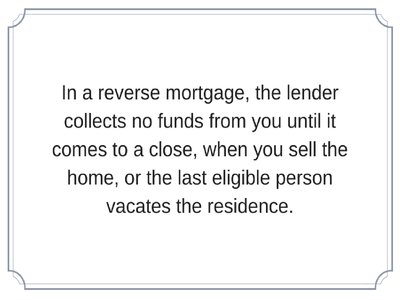HSH.com's comprehensive reverse mortgage guide informs readers about all aspects of these loans, or home equity conversion mortgages (HECMs). Within Part I, articles provide an overview of reverse mortgages, explain how to get one and offer alternatives.

How do reverse mortgages work?
If you've had a home equity loan, a home equity line of credit (or even a credit card or installment loan) you're more familiar with how reverse mortgages work than you might think. In a reverse mortgage, you are borrowing the equity out of your home, which is a pretty simple idea.
After that, reverse mortgages become complicated for a number of reasons. The "no payments" feature means a kind of "reverse amortization," a situation where the amount you borrow or have borrowed generally increases over time. As you're not making any payments to pay off the debt, your balance increases in two ways:
- Your loan amount increases each time you borrow funds
- Your loan amount increases by the interest charged for the use of those funds
There is some complicated math involved to determine how much money you are allowed to borrow. This calculation occurs at the intersection of:
- Your age
- The amount of equity you have available
- Federal loan amount limits
- The cost of certain required insurances
- Your choice of loan terms, and more
Further details can be found in the "Reverse mortgage / HECMs and your finances" and "Technical Stuff" sections of this guide.
Certain loan choices affect how much you can borrow and how much work the lender needs to do on your behalf today and well into the future. For example, making you a one-time, lump sum HECM carries a lot less costs for the lender than does a line of credit, where the lender must make money available to you on demand. As any costs are paid from the proceeds of your reverse mortgage, a choice with higher costs reduces the amount available for you to use. A lump-sum payment means the lender has a lot less work today and in the future for the lender than is the case with a line-of-credit arrangement. There are advantages and disadvantages of lump-sum payouts, discussed in "Reverse mortgage / HECMs and your finances".

How can a reverse mortgage or HECM require no payments?
While it is a mortgage, the borrower isn't required to make payments to the lender. Instead, the size of the available pool of funds (your home's equity) is drawn down by the amount you use plus any interest that is due from using those funds. Over time, this sees the amount of the loan increase, but the lender collects no funds from you until the reverse mortgage comes to a close, when you sell the home, or the last eligible person vacates the residence.
Next: Alternatives to HECMs or reverse mortgages
Previous: Obtaining a reverse mortgage



